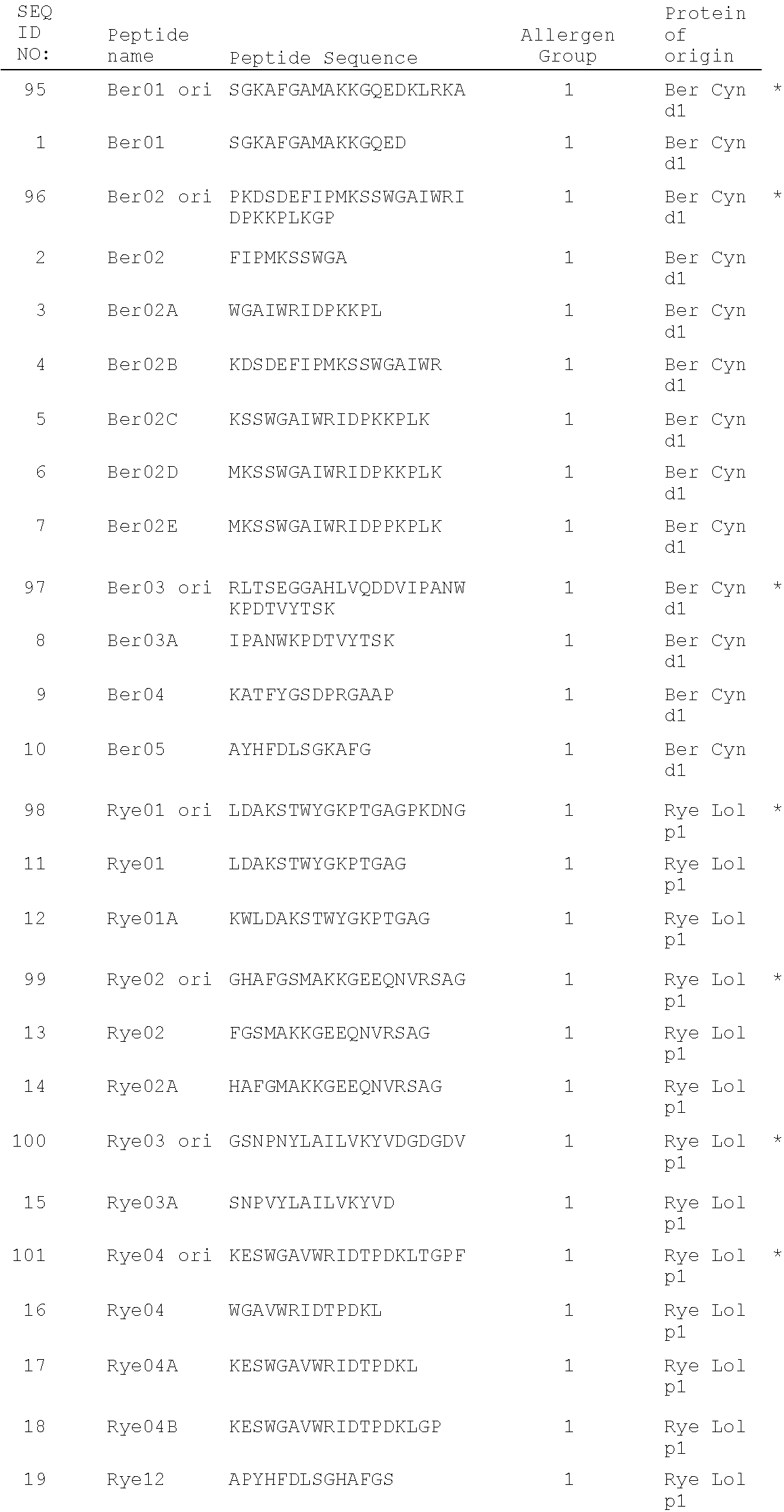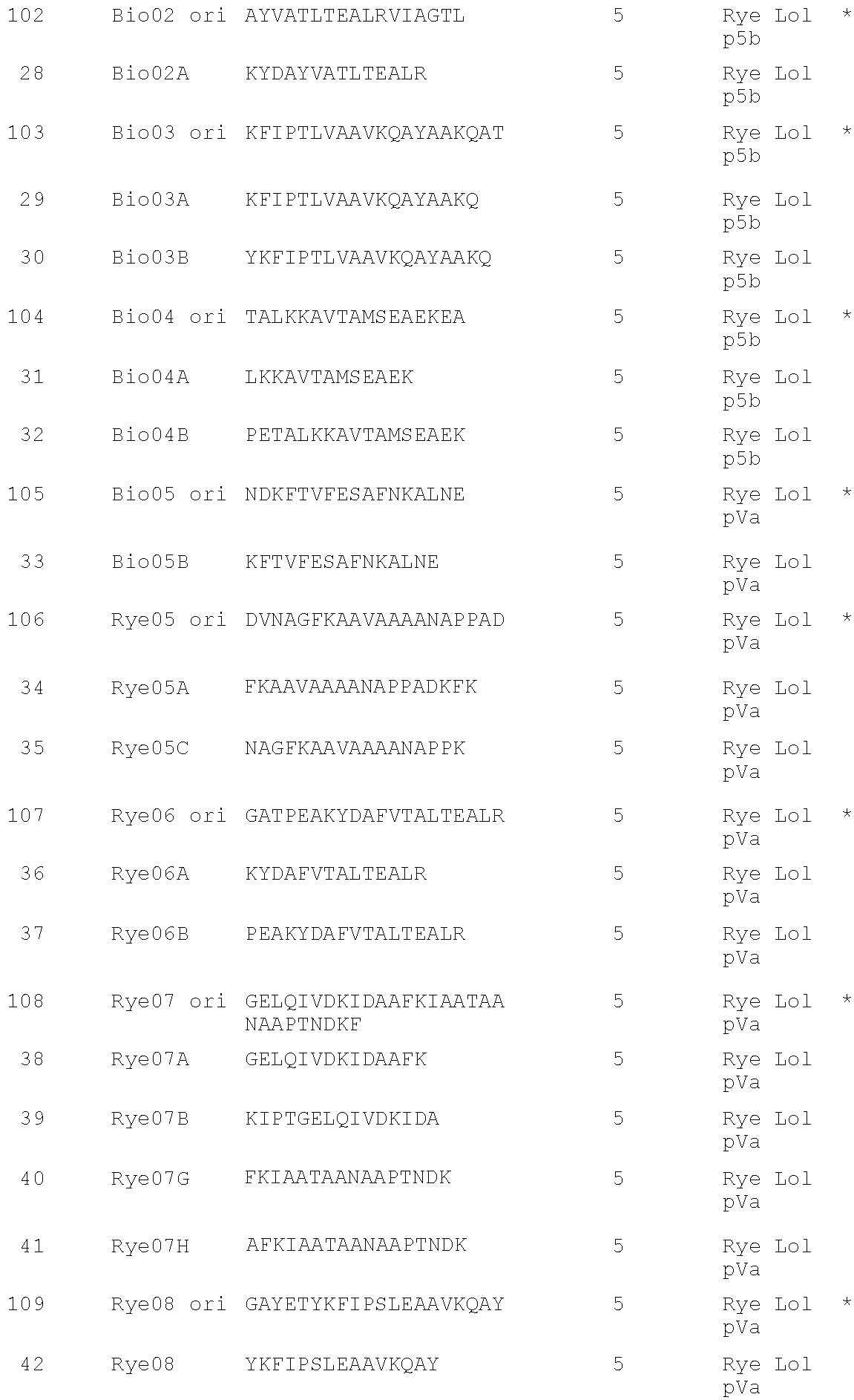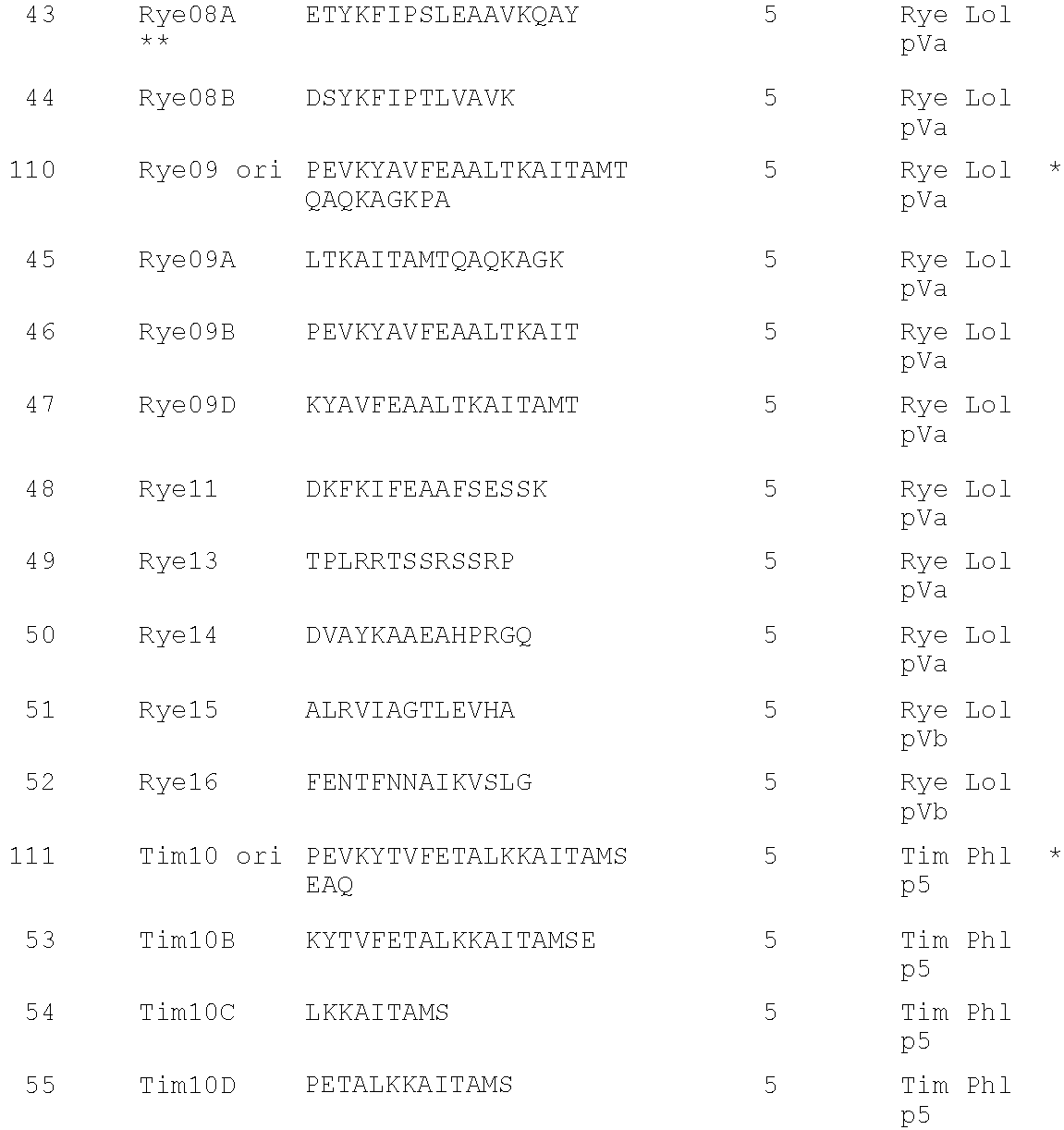Grass peptides for vaccine
a technology of peptides and vaccines, applied in the field of vaccine peptides, can solve the problems of provoking serious side effects, affecting the effectiveness of treatment, and causing more than $700 million in total productivity loss, and achieves good individual response characteristics and advantageous properties
- Summary
- Abstract
- Description
- Claims
- Application Information
AI Technical Summary
Benefits of technology
Problems solved by technology
Method used
Image
Examples
example 1
MHC Class II Binding Search
[0227]The aim of this study is to identify a distinct panel of peptides with strong affinities for the eight most common human MHC Class II HLA-DRB1* allotypes. In order to identify binding peptides in the major grass allergens Rye Lol p 1, Rye Lol p Va, p Vb, p 5a and p 5b, Bermuda Cyn d 1 and Timothy Phl p 5, an in silico approach known as “peptide threading” was employed using the commercially available EpiMatrix algorithm (EpiVax Inc.) This is a bioinformatic analysis of peptides from a sequence for the potential to be accommodated within the binding groove of MHC class II HLA-DR molecules. EpiMatrix is a matrix-based algorithm that ranks 9 amino acid long segments, overlapping by 8 amino acids, from any polypeptide sequence by estimated probability of binding to each of the selected MHC molecules. (De Groot et al., AIDS Research and Human Retroviruses 13:539-41 (1997)). The procedure for developing matrix motifs was published by Schafer et al, 16 Vacc...
example 2
Homology Search
[0235]The sequences of each of the peptides identified above as MHC Class II-binding were used to probe the sequence of alternative proteins in the grass allergen group from which the parent sequence derived. For example, peptide Rye01 is from Lol p 1, therefore the sequence of Rye01 was used to probe for conserved sequences in Group 1 from other grass species, in particular Timothy. The results of this analysis are shown below for the residues of Rye Lol p 1 as indicated, compared with corresponding sequences from Timothy Phl p 1 and Bermuda Cyn d 1:
[0236]
Rye 19-38: LDAKSTWYGKPTGAGPKDNG(SEQ ID NO: 98)(RYE 01 ori)Timothy LDAKSTWYGKPTGAGPKDNG(SEQ ID NO: 98)Rye 109-128: GHAFGSMAKKGEEQNVRSAG (SEQ ID NO: 99)(Rye 02 ori)Timothy GHAFGAMAKKGDEQKLRSAG(SEQ ID NO: 113)Cyn d 1 109-128:SGKAFGAMAKKGQEDKLRKA(SEQ ID NO: 95)Rye 154-173:GSNPNYLAILVKYVDGDGDV (SEQ ID NO: 100)(Rye03 ori)TimothyGSNPNYLALLVKYVNGDGDV(SEQ ID NO: 114)Rye 190-209:KESWGAVWRIDTPDKLTGPF (SEQ ID NO: 101)(Rye04 ori...
example 3
In Vitro Binding Analysis
[0241]The peptides identified as being potential MHC Class II-binding are pre-screened for solubility in an aqueous, acidic milieu and the peptides are tested in an in vitro MHC Class II binding assay.
Methods
[0242]The assay employed is a competitive MHC class II binding assay, wherein each peptide is analysed for its ability to displace a known control binder from each of the human MHC class II allotypes investigated. The allotypes and control peptides used in this study are typically those shown below:
[0243]
ControlSEQ IDAllotypePeptideSequenceNO:DRB1*0301Myco.AKTIAYDEEARRGLE141tuberculosis / leprae hsp 65 2-16DRB1*1101Influenza PKYVKQNTLKLAT142haemagglutinin307-319DRB1*1501Human myelin ENPVVHFFKNIVTPR143basicprotein 85-99Control peptides used in the in vitro binding assays
Each of the peptides from Tables 2 to 4 (excluding those marked *) are analysed in the competition assay and screened for relative binding compared to the control peptides. Due to the natur...
PUM
| Property | Measurement | Unit |
|---|---|---|
| temperature | aaaaa | aaaaa |
| temperature | aaaaa | aaaaa |
| latitudes | aaaaa | aaaaa |
Abstract
Description
Claims
Application Information
 Login to View More
Login to View More - R&D
- Intellectual Property
- Life Sciences
- Materials
- Tech Scout
- Unparalleled Data Quality
- Higher Quality Content
- 60% Fewer Hallucinations
Browse by: Latest US Patents, China's latest patents, Technical Efficacy Thesaurus, Application Domain, Technology Topic, Popular Technical Reports.
© 2025 PatSnap. All rights reserved.Legal|Privacy policy|Modern Slavery Act Transparency Statement|Sitemap|About US| Contact US: help@patsnap.com



